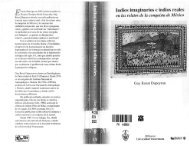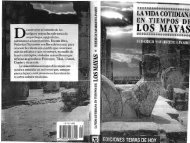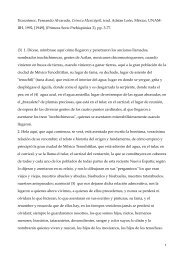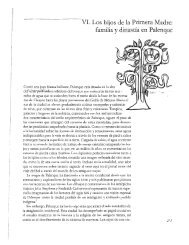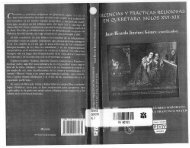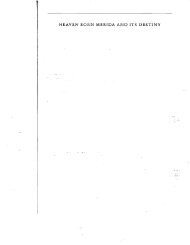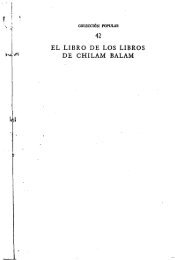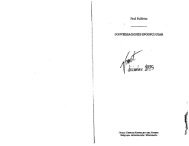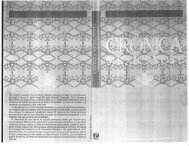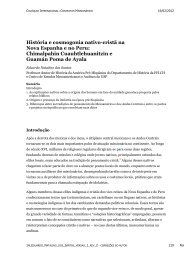1 - Histomesoamericana
1 - Histomesoamericana
1 - Histomesoamericana
You also want an ePaper? Increase the reach of your titles
YUMPU automatically turns print PDFs into web optimized ePapers that Google loves.
was the seat of the cycle to 731<br />
to 771, the end of the Itza cycle,<br />
to 810 to 849 to 889, Chichen<br />
Itza ruled two hundred years.<br />
Then it was destroyed and they<br />
went to Champoton, the home<br />
of the imperial Itza. By 968<br />
they finished subjugating the<br />
THE SEVENTH CENTURY<br />
(Uac Ahau)*<br />
Can Ahau<br />
Cabil Ahau<br />
Ox lahun Ahau<br />
Lai tzolc i*<br />
Pop<br />
Buluc Ahau<br />
Bolon Ahau<br />
Uuc Ahau<br />
Ho Ahau<br />
Ox Ahau<br />
Hun Ahau*<br />
««*« = ^3B> ¿SB»<br />
Lahun kal hab<br />
C u tepal Chi Ch'en Ytza*<br />
Ca pax i<br />
Ca bin ob<br />
T cantal*<br />
Chakan Putun*<br />
Ti y anh i<br />
Y otochob*<br />
Ah Ytzaob<br />
Ku y an uinicob i*<br />
Uac Ahau<br />
Chue cu*<br />
30<br />
35<br />
40<br />
45<br />
50<br />
(6 Ahau) (711),<br />
4 Ahau (731),<br />
2 Ahau (751),<br />
13 Ahau (771).<br />
That was the counting<br />
Of the mats.<br />
11 Ahau (790),<br />
9 Ahau (810),<br />
7 Ahau (830),<br />
5 Ahau (849),<br />
3 Ahau (869),<br />
1 Ahau (889).<br />
Two hundred years<br />
Chichen Itza ruled.<br />
Then it was destroyed.<br />
Then they went<br />
To the settlement<br />
Of Champoton,<br />
Where there were then<br />
The homes<br />
Of the Itza,<br />
The gods who own men.<br />
6 Ahau (968)<br />
Completed the seating<br />
27. Uac Ahau has been omitted.<br />
31. The mats were counted at the end of the (Itza) katun cycle. Since mats<br />
were symbols of authority, frequently paired with thrones, counting them was a<br />
ritual confirmation of inherited ranks. Succession was not automatic,- it involved<br />
an examination in ritual knowledge.<br />
38. Barrera 1948: 60 continues this count down to 8 Ahau, which he interprets<br />
as 692.<br />
40. That is, 692 to 889.<br />
43.1 read ti cahtal.<br />
44. Chichen Itza was the primate city for 200 years. Then it was destroyed and<br />
the primacy was moved to Champoton. This occurred at the end of 8 Ahau or the<br />
beginning of 6 Ahau (ca. 948). A period of 40 years in the wilderness may have<br />
intervened. Being the seat of the cycle [may cu), as opposed to the seat [hetz') of<br />
the katun, theoretically established dynastic preeminence for a period of 260 tuns<br />
(ca. 256 years). The Chumayel gives Chichen Itza the full 260 tuns-, the Tizimin<br />
awards it 200; the Mani strips it to 120. Doubtless, political differences are involved,<br />
but the terminal date is not affected. Chakan Putun 'meadow swamp' is<br />
the modern Champoton. Barrera 1948: 140 translates the name as 'plain of putun<br />
chiles'. Putun also means 'Chontal' (Roys 1935: 4).<br />
46. Otoch 'home' contrasts with na 'house' as a dwelling place as opposed to a<br />
residence. One implication may be that the Itza formerly lived in Champoton.<br />
48. Barrera 1948: 60 has 'religious men'; Brinton 1882: 145 says 'holy men'.<br />
Kuyan 'bent' could also mean 'sacrificed people'.<br />
50. The Chumayel places this in 4 Ahau. It must have been around the end of 6<br />
Ahau and the beginning of 4 Ahau (968).



